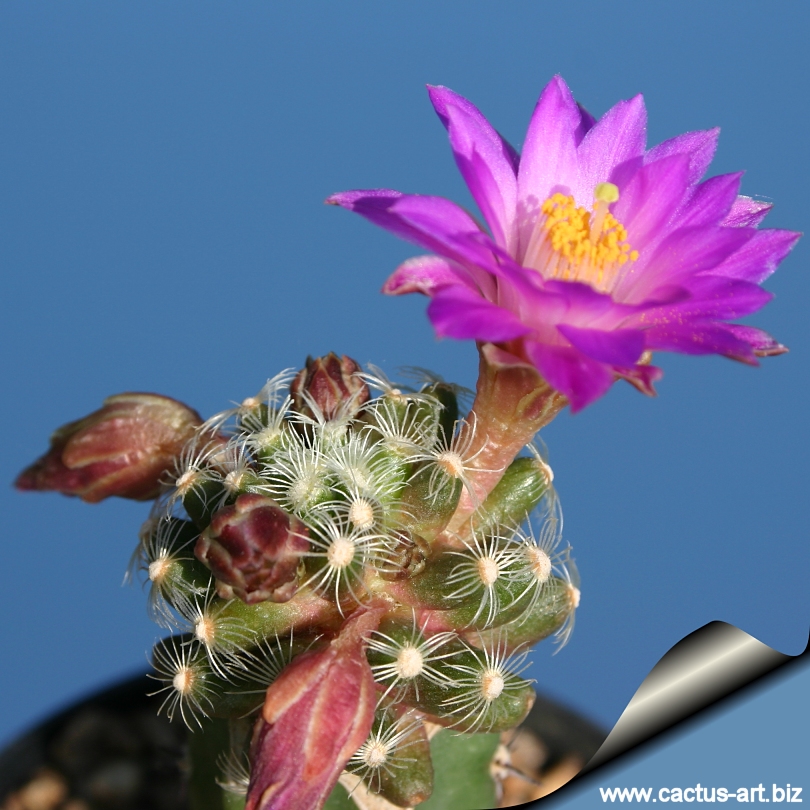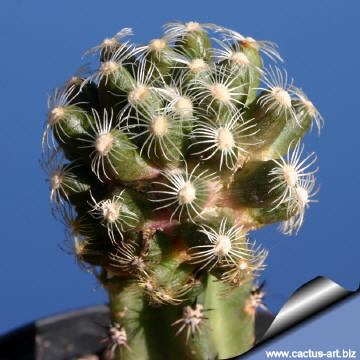|
|
|

Mammillaria saboae ssp. haudeana will form mats of small soft-bodied stems.
|
 |
Subspecies:
-
The subspecies 'saboae' grows in
clumps and has 17-25 radial spines per areole. The flowers are about
4-5 cm across.
-
The subspecies 'goldii' grows only
solitary stems and has 34-45 radial spines per areole. The flowers are
about 4-5 cm across.
-
The subspecies 'haudeana' grows
larger than the former two subspecies, up to 4
cm high, about twice the size of the type,.and
grows in clumps.
It has 18-27 radial spines per areole,
and large flowers 5-6 cm across.
-
The subspecies 'roczekii' It
has a comparatively large stem , usually
solitary (or rarely clustering from the base) with large
flowers and yellow stamens. It comes from Canatlán.
|
|


Advertising
|
|
|
|
|
Family:
Cactaceae (Cactus
Family)
Scientific Name:
Mammillaria saboae ssp. roczekii W. Rischer & Wolfg
Krüger
Published in: MafM 27(2): 50 - 58 2003
Synonyms:
- Mammillaria
roczekii
- Mammillaria saboae Glass 1966
Distribution: Durango, Mexico - near Canatlan.
Habitat: Grows on volcanic rocks with sandy humus soil.
In habitat, the plants contract considerably during the dry season,
sometimes pulling down completely under the soil. Their flowers can push
up through the dirt. |
|
Morphology (Identifying
Characteristics): Mammillaria saboae ssp. roczekii is
a usually solitary (or rarely clustering from the base) geophyte
succulent. It is the fourth discovered species of the Saboae group
and very similar to the other conspecific taxa.
Stem: Tiny, round, soft-bodied,
flattened globose, oblong,10-20 mm in diameter, 20-40 mm tall. Axils
bare, without latex.
Tubercle: Conical, dark green, widely separated, rounded at
the top, somewhat soft, 5 mm wide, 7 - 9 mm long.
Axil: Naked or with some tiny bristles.
Roots: Fleshy taproot (sometime branching) 15 - 50 mm long
and 35 mm in diameter.
Radial spine: 19 - 25, glassy white, interlacing, smooth,
thin, a little curved, 3 to 4 mm long.
Central spine: Absent.
Flowers: Funnelform, large
35 - 50 mm long, 30 - 40 mm wide dark lilac-pink to pinkish magenta,
larger and deeper coloured than the type, stigmas yellow.
Blooming season (Europe): May. It has a reputation of being
shy to flower, at least when on its own roots.
Fruit: Brownish, 4 - 5 mm wide and long. The fruits mature
inside the plant and remain for years
sunken into the stems, as in the type.
|
|
|
|
Cultivation:
Clustering in cultivation and easily flowered it is not really easy. It
has a thick
tuberous root system and
is
susceptible to
over-watering,
and it's especially
prone to rot.
Therefore,
underpot in a shallow pot with good
drainage, filled with a very open mineral-based potting mix, and only
use the smallest diameter pot that will accommodate the plant. . Plants
need to be kept dry in winter. Feed with a high
potassium fertilizer in summer.
Can be sunburned if moved from shade/greenhouse into full sun too
quickly. During the spring it may be able to take full sun until the
heat arrives at the end of spring. In an area that has hot afternoon
sun, it may be able to take full morning sun, but requires afternoon
shade or afternoon light shade.
If grown correctly, it will reward the grower with generous
displays of huge pink-violet flowers.
Initially this species appears easy to cultivate, but the grower should
not be surprised if clumps suddenly dry up, especially in the winter
season. Hardy to -5°C.
Propagation: Seeds, division
off larger clumps or graft. Seeds can be sown in the spring or summer.
The seedlings should not be disturbed until they are well rooted,
after which they can be planted separately in small pots. To make
cuttings wait
until the
offsets that appear at the
base of old clustered
specimens
are 1/3 the size of the parent and then detach and plant.
|
|
Photo of
conspecific taxa, varieties, forms and cultivars of
plants belonging to the
Mammillaria saboae
complex
|
|